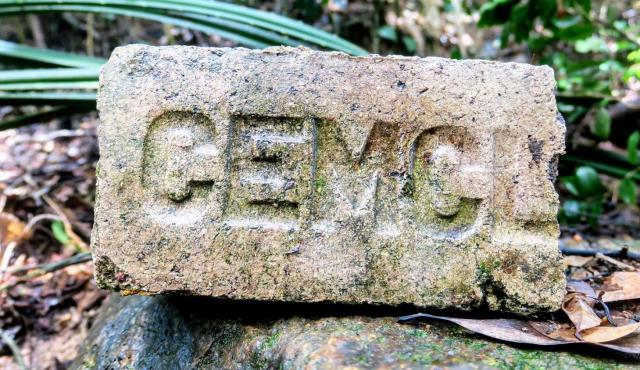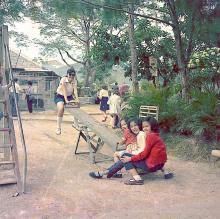The charactor shown on the brick should be part of "CEMCLUB", the short form of Cement Club. This brick might be a product of a UK Organisation which study cement in the old days.
Get Gwulo's books
Directory
Click on your area of interest to choose from over 30,000 pages about old Hong Kong:
- Images & photos
- View - View galleries - View new - Create - Forum topics
- View - Create - Places & buildings
- View map - View new - Create - Streets
- View map - View new - Create - People
- View - View new - Create - Organisations
- View all - View new - Create - Diaries & memoirs
- View - View new - Create diary - Create page - Events
- View - View new - Create - Jurors lists
- View - Type a page
Or choose a popular article:



Comments
Chinese Engineering & Mining Co. Ltd
CEMCL refers to Chinese Engineering & Mining Co. Ltd. Firebricks of the well known C.E.M.C.L. brand are made at the Tongshan Brickworks. Further information here
Cemclub Company
Dear Moddsey, thanks for your sharing. Please see the article attached. In addition, the brick we found was partly broken. Therefore we came to such conclusion. For your further comment please.
Re: Cemclub Co.
Noted the linked article but I doubt very much. I think the focus should be on a company that operated when the aerial ropeway was constructed and when it was in existence. From Wikipedia, Chinese Engineering & Mining Co. Ltd.was established in 1879. The company also mined coal, was well-known and appeared in the local newspapers of the day. Further info: https://www.researchgate.net/publication/333963196_Fire_brick_in_China_From_mining_to_architecture#pf7
CEMCL
Found another reference for the imprint CEMCL here
the CEMCL brick
Hello,
Wonderful to see the local CEMCL brick in Hong Kong. Thanks for sharing the information.
I have photos of exactly the same yellowish refractory brick with CEMCL marks - It is used in the Belgian legation house in Beijing (ca. 1904-07). I could not include the photo in the article since there was no space for that. CEMCL is that British-led mining company based in Tangshan (1900-12; former name Kaiping Mines; later name Kailan Mining Administration).
Also thanks for mentioning my research article. Hope to see more relevant discoveries in Hong Kong.
Changxue Shu
CEMCL Brick found along the Taikoo Arial Ropeway
The Chinese Engineering & Mining Company ( CEMCo.) was established in c.1879 with the sinking of the first coal mines in China using Western practices. The new "Kaping Mine" was actually situated at Tangshan rather than the nearby ancient walled-city of Kaiping. This colliery became the origin of China's first standard gauge railway, built by Englishman C.W Kinder as well becoming closely associated with several other new modern industrial ventures, made feasible by the abundant local supply of high-grade coal. Cantonese entrepreneur, Tong King Sing [ 唐景星 ] ( a.k.a Tang Tingshu [ 唐廷枢 ] , under the patronage of Li Hongzhang was initially the Managing Director of many of these associated industries which included the China Merchants Steam Navigation Company based at Shanghai .
The brickworks at Tangshan appears to have first been established about 1892 and this later developed into the manufacture of cement , eventually becoming a separate subsidiary company under the name of the Tangshan ( and later the “Chee Hsin”) Cement works.
The brickworks initially marketed their product with the logo “CEMCL” moulded into the bricks. Later when CEMCo. was absorbed into the British & Belgian controlled Kailan Mining Administration, the bricks bore the logo “KMA” on them. The high-quality bricks produced at Tangshan were marketed all around China and other parts of the Far East.
In Tangshan there is a Kinder Memorial Hall. Claude William Kinder C.M.G. was the Engineer in Chief of the Chinese Engineering & Mining Company in its formative years and he later went on to build China's first standard gauge railway (Imperial Railways of North China) . KMA manufactured bricks can be found along the pathway leading to this old wooden staff bungalow, which was formerly occupied by the European managers of the various CEMCo.'s subsiduaries.
Customers placing very large orders could have their own corporate logo baked into the bricks .The China Railway Company, which developed into Imperial railways of North China for example, had millions of bricks produced bearing the logo IRNC and these turn up regularly when crumbling properties are torn down or redeveloped along the railway tracks between Beijing & Shenyang.
This railway line after the fall of the Qing Dynasty became the : Peking-Mukden Railway, with their own bricks stamped PMR and later PNR when the railway’s name changed to the “Pei-Ning Railway” in the post 1927 Republican era.
A collection of Chinese manfactured bricks from the early 20th Century ( kindly contributed by Wang Wei) .
There are some extracts from the Chronicle & Directory of China, Japan. Corea , etc., etc and The Far Eastern Review about the various industries centred around the Tangshan colliery at these Researchgate links here. ( Click on Research, then Project Log and then download the pdf documents .)